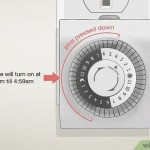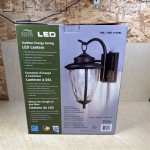Outdoor Motion Sensor Light Turns On And Off Repeatedly: Troubleshooting and Solutions
Outdoor motion sensor lights are designed to provide security and convenience, illuminating areas when movement is detected. However, a common issue is the light turning on and off repeatedly, often without any apparent cause. This erratic behavior can be frustrating, wasteful of energy, and may even indicate an underlying problem that needs attention. Understanding the potential causes and troubleshooting steps is crucial for resolving this issue and ensuring the reliable operation of the motion sensor light.
The continuous on-off cycling, sometimes referred to as "falsing," can stem from a variety of factors ranging from environmental influences to electrical problems and sensitivity settings. A systematic approach to diagnosis and repair is generally the most effective way to identify and rectify the root cause. This article will explore several common reasons why an outdoor motion sensor light might exhibit this behavior and provide practical solutions for each scenario.
Environmental Factors and Interference
One of the most frequent culprits behind motion sensor light malfunctions is environmental factors. These lights are designed to detect changes in infrared radiation, and various natural phenomena can trigger false activations. Understanding these factors is essential for proper placement and adjustment of the sensor.
Wind can cause plants, trees, and even decorations to move within the sensor's range, mimicking the movement of a person or animal. Tall grasses waving in the breeze, tree branches swaying back and forth, and even reflective objects like flags or aluminum foil can create enough infrared fluctuation to trigger the sensor. The sensor interprets this movement as a potential threat or presence, causing it to activate the light.
Rain and snow can also affect the sensor’s performance. Large raindrops falling within the sensor's field of view can be interpreted as movement. Furthermore, the reflection of light off wet surfaces or the accumulation of snow can create infrared variations that trigger the sensor. Similarly, sudden changes in temperature, such as sunlight quickly warming a surface, can generate enough infrared heat to activate the light, especially if the sensor is positioned to face a surface that experiences direct sunlight.
Animals, particularly small ones like birds, squirrels, or insects, crossing the sensor's path can trigger the light, especially if the sensitivity is set high. These creatures may be too small to pose a real security threat, but their movement is sufficient to activate the sensor. Similarly, larger animals such as cats, dogs, or deer can also activate the sensor, depending on their size and distance from the sensor.
Addressing environmental interference often involves relocating the sensor, adjusting its sensitivity, or trimming vegetation. Repositioning the sensor to avoid direct exposure to wind-blown objects or reflective surfaces can significantly reduce false activations. Lowering the sensitivity setting makes the sensor less likely to be triggered by minor movements. Trimming vegetation near the sensor's field of view eliminates a common source of false triggers.
Consider the placement of the light fixture itself. Is it exposed to direct sunlight for extended periods? Is it positioned near a heat source like a dryer vent or air conditioning unit? These factors can contribute to temperature fluctuations that trigger the sensor. Sometimes, simply relocating the entire fixture a few feet can alleviate the problem.
Electrical Issues and Wiring Problems
Electrical problems are another potential cause of motion sensor light malfunctions. Ensuring proper wiring and voltage is crucial for the reliable operation of the device. Fluctuations in the electrical supply or faulty wiring can lead to erratic behavior and the light turning on and off repeatedly.
Voltage fluctuations in the power supply can cause the sensor to malfunction. These fluctuations can be caused by other appliances on the same circuit drawing large amounts of power, or by issues with the electrical grid itself. The motion sensor requires a stable voltage to operate correctly, and any variations can disrupt its functionality, leading to false activations or the light turning on and off randomly.
Loose wiring connections are a common problem that can cause intermittent issues with motion sensor lights. Vibration, temperature changes, and general wear and tear can loosen the connections at the light fixture, the sensor, or within the junction box. These loose connections can create a break in the circuit, causing the light to flicker or turn on and off repeatedly. Additionally, corrosion on the wiring can also impede the flow of electricity, resulting in similar problems.
A faulty sensor is another possibility. Over time, the sensor itself can degrade or become damaged, leading to inaccurate readings and false activations. This is especially true for older sensors or those exposed to harsh weather conditions. A diagnostic test or replacement of the sensor may be necessary to resolve the issue.
To troubleshoot electrical issues, start by checking the circuit breaker for the light. Ensure it is not tripped or loose. If it is tripped, reset it and monitor the light's behavior. If the breaker trips repeatedly, there may be a short circuit that needs to be addressed by a qualified electrician. Inspect the wiring connections at the light fixture and within the junction box. Ensure that all connections are tight and secure. Look for signs of corrosion or damage to the wires. If any are found, clean the connections or replace the damaged wires.
A multimeter can be used to test the voltage at the light fixture. Verify that the voltage is within the specified range for the light. If the voltage is unstable or outside the acceptable range, there may be an issue with the power supply or the wiring. In cases of complex electrical problems, consulting a qualified electrician is recommended to ensure safety and proper repair.
Sensitivity and Range Settings and Bulb Compatibility
Improper sensitivity and range settings, along with incompatible bulbs, can also contribute to motion sensor light malfunctions. Understanding how these settings affect the sensor's behavior and ensuring compatibility with the installed bulb is crucial for proper operation.
The sensitivity setting determines how sensitive the sensor is to movement. A higher sensitivity setting will cause the light to activate with even the slightest movement, while a lower sensitivity setting requires more significant movement to trigger the light. If the sensitivity is set too high, it can be easily triggered by minor environmental factors, such as insects, wind, or temperature changes. Adjusting the sensitivity to a lower setting can reduce these false activations.
The range setting determines how far the sensor can detect movement. A longer range setting will allow the sensor to detect movement from a greater distance, while a shorter range setting will limit the detection area. If the range is set too long, it can detect movement from beyond the intended area, such as passing cars or distant objects. Reducing the range setting can prevent these unwanted activations.
Using an incompatible bulb can also cause problems with motion sensor lights. Some motion sensors are designed to work with specific types of bulbs, such as incandescent, halogen, or LED. Using a bulb that is not compatible with the sensor can cause it to malfunction or not work at all. Always check the manufacturer's specifications to ensure that the bulb is compatible with the motion sensor.
Some LED bulbs, while energy-efficient, may not be fully compatible with older motion sensors. This incompatibility can cause the light to flicker, turn on and off repeatedly, or not turn on at all. It is generally suggested to use a LED bulb specifically designed for use with motion sensors. These bulbs incorporate circuitry that allows them to work correctly with the sensor.
Experiment with different sensitivity and range settings to find the optimal level for your specific environment. Start by lowering the sensitivity and range settings and gradually increase them until the light is only triggered by the intended movements. Ensure that the bulb is compatible with the motion sensor. Check the manufacturer's specifications to confirm compatibility and replace the bulb if necessary. If the problem persists, try using a different type of bulb to see if that resolves the issue.
In summary, addressing the issue of an outdoor motion sensor light turning on and off repeatedly requires a systematic approach. Environmental factors, electrical problems, and incorrect sensitivity settings can all contribute to this behavior. Identifying the root cause and implementing the appropriate solutions is crucial for ensuring the reliable and efficient operation of the light.

Electrical Motion Sensor Lights Constantly On Only Or Off Home Improvement Stack Exchange

How To Reset A Motion Light That Stays On All The Time

Defiant Par 180 Degree Black Motion Sensor Wired Outdoor 2 Head Dusk To Dawn Security Flood Light 17000162 The Home Depot
My Outdoor Security Light Won T Turn Off George Brazil Plumbing Electrical

Defiant Par 180 White Motion Sensing Security Light Wired Outdoor 2 Head Dusk To Dawn Flood 17000163 The Home Depot

How To Stop A Motion Sensor Light From Turning Off Rayzeek

Energetic Outdoor A19 Motion Sensor Light Bulb 60 Watt Equivalent 8 5w Automatic Activated By E26 5000k Dusk To Dawn Security Bulbs 2

7 Best Outdoor Motion Sensor Lights According To Our Testing

Ge Led Linkable Motion Sensor Light Bulb Par38 3 Pack

How To Reset A Motion Sensor Light The Home Depot
Related Posts







